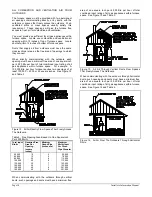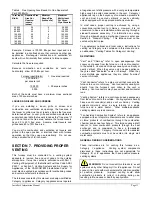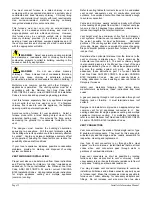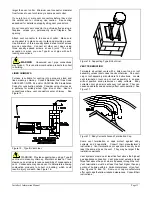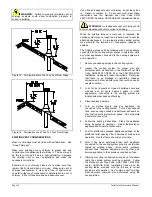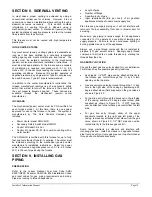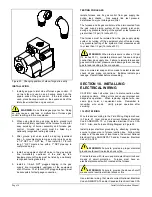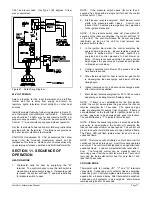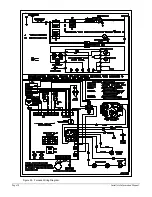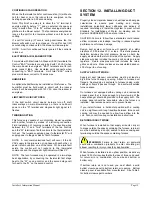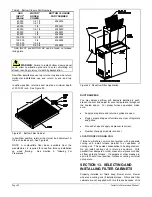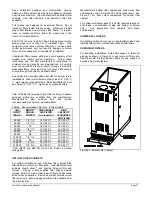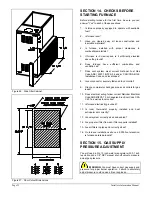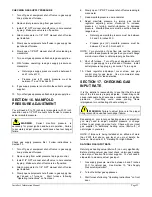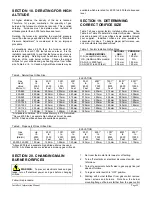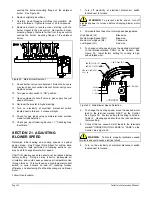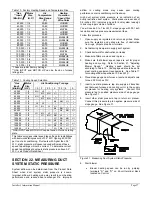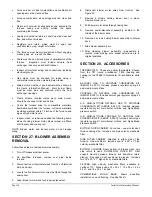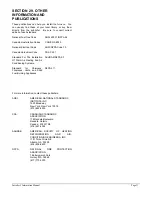
Page 24
Installer’s Information Manual
4. Let furnace warm up for 6 minutes.
5. Locate gas meter. Determine which dial has the least
cubic feet of gas and how many cubic feet per
revolution it represents. This is usually one-half, one or
two cubic feet per revolution.
6. With stopwatch, measure time it takes to consume two
cubic feet of gas.
•
If dial is one-half cubic foot per revolution,
measure time for four revolutions.
•
If dial is one cubic foot per revolution, measure
time for two revolutions.
•
If dial is two cubic feet per revolution, measure
time for one revolution.
7. Divide this time by two. This gives average time for
one cubic foot of gas to flow through meter. Example:
If it took 58 seconds for two-cubic feet to flow, it would
take 29 seconds for one-cubic foot to flow.
8. Calculate gas input using this formula:
Gas Heating Value (Btu/cu.ft.)
x 3,600 sec/hr
Gas input =
= Btu/hour
Time
(Seconds
for
one cubic foot of gas)
Example:
Assume it took 29 seconds for one cubic foot of gas to flow
and heating value of 1,000 Btu/cu.ft.
1,000 x 3,600
Gas Input =
= 124,138 Btu per hour
29
If you left no other pilots on, this is the furnace gas input.
9. If you left water heater, dryer or range pilots on, allow
for them in calculating correct furnace gas input. A
quick way is to allow 1,000 Btu per hour for a water
heater, 500 Btu per hour for dryer and 500 Btu per hour
for each range burner pilot.
Example:
If you left gas water heater, dryer, two range burner pilots
and one oven pilot on, allow:
Water heater pilot
1,000 Btu per hour
Dryer pilot
500 Btu per hour
2 range burner pilots
1,000 Btu per hour
1 range oven pilot
500 Btu per hour
3,000 Btu per hour
Subtracting 3,000 Btu per hour from 124,138 Btu per hour
measured above equals 121,138 Btu per hour. This would
be the correct furnace gas input after allowing for pilots left
on.
10. Manifold pressure may be adjusted within the range of
3.2 inches W.C. to 3.8 inches W.C. to get rated input ±
2 percent. See Section 16, "Manifold Pressure
Adjustment." If you cannot get rated input with
manifold pressure within the allowable range, you must
change orifices. See Section 20, "Changing Main
Burner Orifices."
PROPANE (LP) GAS INPUT RATE
WARNING
: Propane (LP) gas installations do not
have gas meters to double check input rate. Measure
manifold pressure with an accurate manometer. Failure to
accurately adjust pressure could cause heat exchanger
failure, asphyxiation, fire or explosion, resulting in damage,
injury or death.
1. Make sure you have correct main burner orifices.
2. Gas supply pressure must be between 11 and 13
inches W.C. for propane (LP) gas. See Section 15,
"Gas Supply Pressure Adjustment."
3. Start furnace following "Operating Instructions" on front
door.
4. Let furnace warm up for 6 minutes.
5. Adjust manifold pressure to 10.0 inches W.C. ± 0.3
inches W.C. See Section 16, "Manifold Pressure
Adjustment."
WARNING
: Do not set Propane (LP) manifold
pressure at 11.0 inches W.C. It could cause heat
exchanger failure.
NOTE: NOx reducing screens must be removed from each
tube of California NOx furnaces when converting to
propane (LP) gas. See Figure 28.
Figure 28. California NOx Screen Removal.

